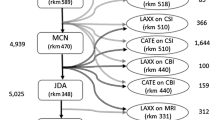Abstract
A general model is developed to examine the patterns of the regional movement of tagged and released fish from mark-recapture experiments. It is a stochastic model that incorporates fishing mortality, natural mortality, fish movement, tag-shedding, and different rates of reporting. A likelihood function is constructed for estimating its parameters. We used this model to analyze data on the Pacific halibut from mark-recapture experiments conducted by the International Pacific Halibut Commission (IPHC), with a total of 36,058 releases from 1982 to 1986 and 5,826 recoveries from 1982 to 2000. We estimated their rates of movement among IPHC management areas, along with their instantaneous rates of natural and fishing mortalities. Our analysis revealed that fish movement was not significant among areas, with a resident probability of > 0.92. This lends support to the IPHC catch-at-age stock assessment model (which has no built-in movement components). The estimated instantaneous rate of natural mortality (0.198 year−1) lies between that assumed in all IPHC stock assessments before 1998 (0.20 year−1) and that from 1999 onwards (0.15 year−1). The estimates of the instantaneous rates of fishing mortality were consistent with those from the IPHC stock assessment model.
Similar content being viewed by others
References
Best EA (1968). Studies of young halibut: census of juveniles. Western Fish 75(5):38–41, 59–60.
C Brownie DR Anderson KP Burnham DS Robson (1985) ArticleTitleStatistical inference from band-recovery data—a handbook, 2nd edn US Fish Wildl Serv Resour Publ 156 305
WG Clark (1999) ArticleTitleEffects of an erroneous natural mortality rate on a simple age-structured stock assessment Can J Fish Aquat Sci 56 1721–1731 Occurrence Handle10.1139/cjfas-56-10-1721
WG Clark AM Parma (1999) ArticleTitleAssessment of the Pacific halibut stock in 1999 Int’l. Pac. Halibut Comm. Rep Assessment Res Activ 1999 109–137
J Heifetz JT Fujioka (1991) ArticleTitleMovement dynamics of tagged sablefish in the northeastern Pacific Fish Res 11 355–374 Occurrence Handle10.1016/0165-7836(91)90009-5
R Hilborn (1990) ArticleTitleDetermination of fish movement patterns from tag recoveries using maximum likelihood estimators Can J Fish Aquat Sci 47 635–643 Occurrence Handle10.1139/f90-071
Kaimmer SM (2000). Pacific halibut tag release programs and tag release and recovery data. 1925–1998. Int Pac Halibut Comm Tech Rep 41.
JG Kalbfleisch (1985) Probability and statistical inference Springer-Verlag New York
P McCullagh JA Nelder (1983) Generalized linear models Chapman and Hall London
KB Newman (1998) ArticleTitleState-space modeling of animal movement and mortality with application to salmon Biometrics 54 274–297
KB Newman (2000) ArticleTitleHierarchic modeling of salmon harvest and migration J Agr. Biol., Environ Stat 5 98–123
KB Newman J Rice (2002) ArticleTitleModeling the survival of chinook salmon smolts outmigrating through the lower Sacramento river system J Am Stat Assoc 97 983–993 Occurrence Handle10.1198/016214502388618771
JD Nicholas SL Stokes JE Hines MJ Conroy (1982) ArticleTitleAdditional comments on the analysis of homogeneous survival rates in modern bird banding estimation models J Wildl Manag 46 953–962
KH Pollock DG Raveling (1982) ArticleTitleAssumptions of modern band-recovery models with emphasis on homogeneous survival rates J Wildl Manag 46 88–98
TJ Quinn RB Deriso (1999) Quantitative fish dynamics Oxford University Press Inc. Oxford
CJ Schwarz JF Schweigert AN Arnason (1993) ArticleTitleEstimating migration rates using tag recovery data Biometrics 49 177–193
JF Schweigert CJ Schwarz (1993) ArticleTitleEstimating migration rates for Pacific Herring (Clupea pallasi) using tag-recovery data Can J Fish Aquat Sci 50 1530–1540 Occurrence Handle10.1139/f93-174
Skud BE (1977). Drift, migration, and intermingling of Pacific halibut stocks. Int Pac Halibut Comm Sci Rep 63.
PJ Sullivan AM Parma WG Clark (1999) ArticleTitleThe Pacific halibut stock assessment of 1997 Int Pac Halibut Comm Sci Rep 79 1–84
Thompson WF, Herrington WC (1930). Life history of the Pacific halibut. (1) Marking experiments. Rep, Int Fish Comm 2.
RJ Trumble IR McGregor G St-Pierre DA McCaughran SH Hoag (1990) ArticleTitleSixty years of Tagging Pacific Halibut: A Case Study Am Fish Soc Symp 7 831–840
Y Xiao (1996) ArticleTitleA general model for estimating tag-specific shedding rates and tag interactions from exact or pooled times at liberty for a double tagging experiment Can J Fish Aquat Sci 53 1852–1861 Occurrence Handle10.1139/cjfas-53-8-1852
Author information
Authors and Affiliations
Corresponding author
Additional information
Received: April 2003 / Revised: May 2005
Rights and permissions
About this article
Cite this article
Chen, DG., Xiao, Y. A General Model for Analyzing Data from Mark-recapture Experiments with an Application to the Pacific Halibut. Environ Ecol Stat 13, 149–161 (2006). https://doi.org/10.1007/s10651-005-0002-4
Issue Date:
DOI: https://doi.org/10.1007/s10651-005-0002-4




